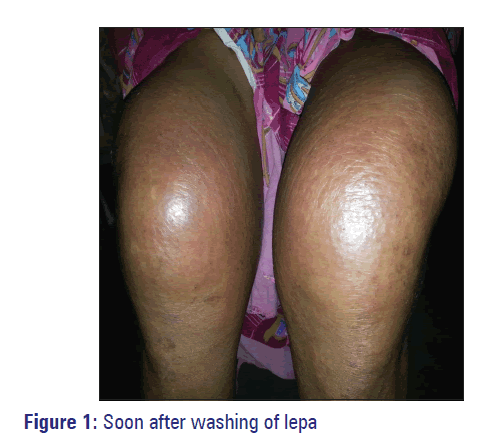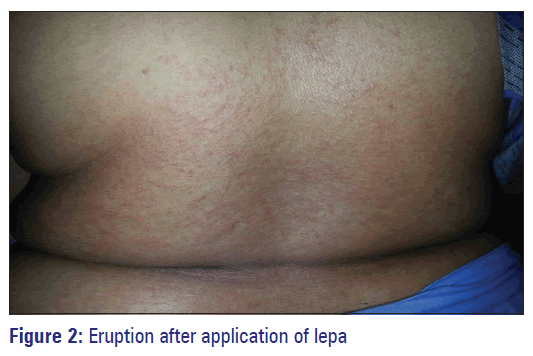Type I hypersensitivity reaction as a complication of lepa
- *Corresponding Author:
- Dr. Deepa Manjunath Janthli
#39, Hemavathi Road, Gururaj Layout, Near Terresian College, Mysore - 570 011, Karnataka, India.
E-mail: deepasandeep30@gmail.com
This is an open access article distributed under the terms of the Creative Commons Attribution-Non Commercial-Share Alike 3.0 License, which allows others to remix, tweak, and build upon the work non-commercially, as long as the author is credited and the new creations are licensed under the identical terms.
Abstract
Adverse drug reaction is defined as response to a drug which is noxious and unintended, and which occurs at doses normally used in man for the prophylaxis, diagnosis or therapy of disease, or for the modification of physiological functions. Type I hypersensitivity reaction is known as anaphylactic reaction which is due to immediate immunoglobulin E‑mediated reaction. It is characterized by symptoms such as fever nausea, back pain, angiodema, rash, flushing, etc. Lepa generally refers to the application of pastes formed by mixing powder of herbs with water, milk, etc., and liquids. Complementary and alternative medicines are frequently used by the general population. Many people consider them to be without side effects. Ayurvedic treatment involves Shodhana (biopurification), Shaman (pacification), Bahya (external therapy), and Abhyantara karma’s (internal therapy) for treating different diseases. One such bahya karma or external therapy is lepa. Even though lepa is said as “Aadhya Upakrama,” undue hypersensitivity is observed in many patients. A 60‑year‑old woman had an adverse reaction to lepa after being administered as an external medication. The observations were erythema, eruptions, and itching. Such case of hypersensitivity is discussed in the present study.
Keywords
Adverse drug reaction, Ayurveda, lepa, Type 1 hypersensitivity
Introduction
Adverse drug reactions (ADRs) are the cause of concern in any clinical practice or system of medicine, [1] and Ayurveda is not an exception. ADR is defined as response to a drug which is noxious and unintended, and which occurs at doses normally used in man for the prophylaxis, diagnosis or therapy of disease, or for the modification of physiological functions. [2] ADRs have proved a significant problem in healthcare for decades their incidence is influenced by many factors and their severity and outcome may vary. [3]
The immune system of a human being is an integral part of human protection against disease. Normally, protective immune mechanism can sometime cause harmful reactions in host which are known as hypersensitivity reactions. [4] Hypersensitivity reactions originally divided into two categories: Immediate and delayed. In 1968, Coombs and Gell defined the four types which are followed today: [5]
• Type I: Classical immediate hypersensitivity
• Type II: Cytotoxic hypersensitivity
• Type III: Immune complex mediated hypersensitivity
• Type IV: Cell-mediated or delayed hypersensitivity.
Complementary and alternative medicines are frequently used by the general population. Many people consider them to be without side effects. Ayurveda, the Indian system of medicine, is one of the oldest systems of medicine; dating back to 5000 B.C. Ayurvedic treatment involves Shodhana (biopurification), Shaman (pacification), Bahya (external therapies), and Abhyantara karma’s (internal administration of drugs) for treating different diseases. One such Bahya karma or external therapy is lepa (application of pastes of herbal medications).
Lepa is one of the Ayurvedic treatment modalities which are routinely practiced in many diseases. It had been given a lot of importance in almost all the classics of Ayurveda. Sushrutha has given a lot of importance to lepa by saying it as “Addhya Upakrama.” It is Pradhanatama Upakrama for curing Sarva Shopha, that is, all kind of inflammations. [6] A detail description regarding rules and regulations to be followed during the course of lepa is also been described in all the classics.
Lepa generally refers to the application of pastes formed by mixing powder of herbs with water, milk, etc., and liquids. It is usually applied in opposite direction of the hair follicle to facilitate the easy absorption of medicines. [7] Even though lepa is said as “Aadhya Upakrama,” Undue hypersensitivity is observed in many patients. Such case of hypersensitivity is discussed in the present study.
Case Report
A 60-year-old female patient came to the Department of Panchakarma, as an outpatient, Shree Dharmasthala Manjunatheshwara College of Ayurveda and Hospital, Hassan. Patient’s chief complaints were pain and swelling in the bilateral knee joints for 6 months which was diagnosed as a case of Sandhigata vata (osteoarthritis) and was admitted as an inpatient.
The vitals of the patient on the day of admission were normal with pulse 76/min, B.P 120/90 mm of Hg, and the temperature being afebrile. The patient attained menopause 10 years back. The patient was from the rural locality and hence was used to laborious work. The symptoms of sandhigata vata in the patient were gradual in onset and progressive in the course. The patient is used to take a diet which is generally composed of Roti (Kind of Indian bread) and vegetables.
The bowel habit of the patient was regular, once a day with normally formed stools. On assessing the patient in detail, following treatment was planned:
• Janubasti with Mahanaryana Taila (retention of medicated oils over knee joints)
• Tab. Yogaraja Guggulu 1 Bd
• Astavarga kashaya 2 tsp TID
• Lepa with Dashanga Lepa Choorna + Marmanivati.
The treatment was started on the day of admission. The Dasanga lepa with marmani vati was applied to the patient in the afternoon. The patient was asked to wash lepa after getting dried with hot water. After washing, the lepa patient was alright until evening. At late evening, the patient started getting the itching at the place where the lepa was applied. Next morning, the patient was reported with erythematous maculo-papular eruptions on bilateral knee joints associated with redness and itching as seen Figures 1 and 2. The application of lepa was stopped.
Discussion
It is a part of Bahirparimarjana Chikitsa in removing the morbid factors locally. Lepa should always be applied in the opposite direction of the hair follicles, by this way, the medicines stays properly (on the wound), enters into the hair follicles and channels of sweat and gets absorbed by the orifices of the Siramukha. [7] The lepa should not be left in site for drying except in conditions, where Peedanakarya is required, because lepa in wet state help to cure the diseases; whereas on drying it loose its potency and irritate the skin. [8] Lepa should never be applied one over the other, by doing so it gives rise to increased ushna, vedana, and daha, because of its thickness. [9] The same paste should not be used again. It does not serve the purpose, even though applied properly, because of its dryness and lack of potency. [10]
The lepa is mentioned as one of the treatment modality for Sandhigata Vata (osteoarthritis) in Ayurvedic classics. Along with the internal therapies, external therapies play a major role in the treatment of Sandhigata Vata. They help in the reduction of swelling and thereby also help in relieving pain. [10]
In clinical practice, the cutaneous administration is used mainly when a local effect is required (example topical application of steroid) appreciable absorption may nonetheless occur and lead to systemic effects. [11] High concentrations are attained at the desired site without exposing the rest of body. Drug is applied as ointment, lotion, powder, pastes, etc. Highly lipid soluble drugs can be applied over the skin for slow and prolonged absorption. The action by the liver is also by-passed in the case of topical applications. [12]
Just like Agni getting Shanta after putting water, dosha also gets pacified after applying lepa. [13] Lepa cures pain and causes happiness and is also useful as Sodhana, Sophahara, and does Utsadana. [14]
Probable mode of action of lepa
In the chapter Dhamani Vyakarana Adhyaya, [10] Sushrutha says that there are four types of Dhamanis. Among these four Tiryakgami Dhamanis, each divides gradually into many branches and thus become innumerable. These cover the body just like a network. These Dhamanis bound and pervade their openings and are attached to hair follicles. These carry the sweat and replenish rasa inside and outside. It is through these Dhamanis only the Veerya of all Bahirparimarjana Chikitsa’s such as Abhyanga, lepa, etc., enter the body after being transformed in skin by Brajaka Agni. Ayurveda has mentioned the use of medicines in the form of the transdermal route since the time immemorial.
Financial support and sponsorship
Nil.
Conflicts of interest
There are no conflicts of interest.
References
- International drug monitoring: The role of national centres. Report of a WHO meeting. World Health Organ Tech Rep Ser 1972;498:1-25.
- WHO. Handbook of Resolutions and Decisions of the World Health Assembly and Executive Board, WHA 16.36. Clinical and Pharmacological Evaluation of Drugs. Vol. 1948-1972. Geneva: WHO; 1973.
- Davies EC, Green CF, Mottram DR, Pirmohamed M. Adverse drug reactions in hospitals: A narrative review. Curr Drug Saf 2007;2:79-87.
- John Hopkins Nursing Magazine. Acute Hypersensitivity Reactions: What Nurses Need to Know; 2011. p. 89.
- Hogarth-Scott RS, Johansson SG, Bennich H. Antibodies to Toxocara in the sera of visceral larva migrans patients: The significance of raised levels of IgE. Clin Exp Immunol 1969;5:619-25.
- Sushruta, Sushruta Samhita with Nibandha Sangraha commentary Choukhamba Sanskrit series Chikitsa Sthana, 33/36. Varanasi: India; 2002. p. 228.
- Sushruta, Sushruta Samhita with Nibandha Sangraha commentary Choukhamba Sanskrit series Sutra Sthana, 18/4. Varanasi: India; 2002. p. 78.
- Sushruta, Sushruta Samhita with Nibandha Sangraha commentary Choukhamba Sanskrit series Uttar Tantra, 11/4. Varanasi: India; 2002. p. 578.
- Sushruta, Sushruta Samhita with Nibandha Sangraha commentary Choukhamba Sanskrit series Sutra Sthana, 18/15. Varanasi: India; 2002. p. 178.
- Sushruta, Sushruta Samhita with Nibandha Sangraha commentary Choukhamba Sanskrit series, Chikitsastana, 4/15. Varanasi: India; 2002. p. 128.
- Rang HP, Dale MM. Pharmacology. 1st ed. London: English Language Book Society/Churchill Livingstone; 1987. p. 52.
- Tripathi KD. Essentials of Medical Pharmacology, Third Edition Reprint. New Delhi: Jaypee Brothers Medical Publishers (P) Ltd.; 1995. p. 67.
- Vagbhata; Astanga Samgraha with Sasilekha Commentary, Uttar tantra 30/5-6. Varanasi: Choukambha Krishnadas Academy; 2006. p. 282.
- Sushruta, Sushruta Samhita with Nibandha Sangraha commentary Choukhamba Sanskrit series Chikitsa Sthana, 1/15. Varanasi: India; 2002. p. 128.



